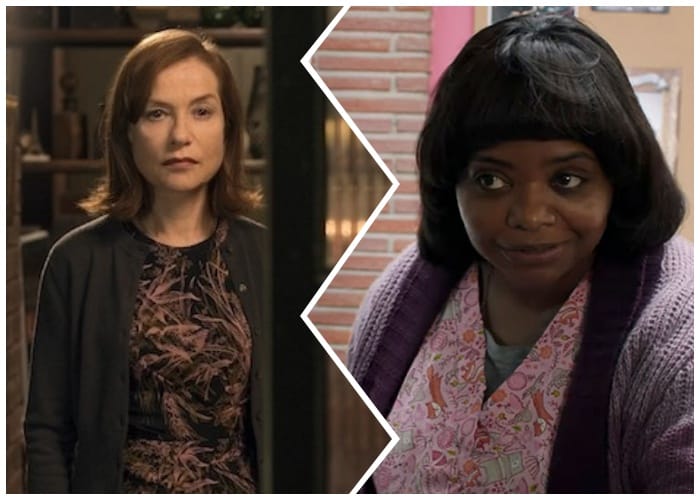
This year, beloved actresses Isabelle Huppert and Octavia Spencer inhabited against-type roles in Greta and Ma, respectively. The characters have been sold as lonely, pitiable women who turn to violence as a direct result of their isolation, but the implication is intentionally misleading. Their pasts heavily inform their motivations as antagonists, with trauma, mental illness, and revenge functioning much more prominently than we’re led to expect.
While both Greta and Ma dip into stereotypes of middle-aged spinsterhood, they also subvert them and encourage us to acknowledge our preconceptions of single women of a certain age. The title characters are each just as terrifying and conniving as their male counterparts, and, while their loneliness is a factor to their villainy, it is not central to their narratives. Greta and Ma represent a return to the cruel, sociopathic vilenesses whose evilness isn’t rooted in gender stereotypes.
Spoilers for both Greta and Ma follow.
In Greta, Huppert’s character is introduced as a kind-hearted, lonely woman seeking companionship. When Frances (Chloë Grace Moretz) returns her purse, she learns Greta is widowed and has a daughter living in Paris. Sympathizing with the lonesome woman, Frances buys Greta a dog and grows increasingly close to her. Then she finds a drawer in Greta’s house full of identical purses containing the contact information of various girls, including her own.
Greta turns out to be lying about her French background (she’s actually Hungarian) and about her daughter, who killed herself four years earlier. It’s implied that Greta had something (or a lot) to do with it. What follows is a dark tale of stalking and mental illness, culminating in Greta kidnapping Frances and murdering multiple victims. The most disturbing scene shows Frances, hiding in her captor’s basement, as she stumbles across a girl in a bodybag, struggling to breathe. As she goes to save the young girl, Greta strangles Frances with a plastic bag until she passes out. While it does seem like Greta is looking for companionship, she’s also a serial killer who hunts young girls meticulously and sadistically for the sole reason that she can. She weaponizes her perception as sympathetic, frail and harmless, luring young girls to her house until she has them trapped. She’s like a pitcher plant, drawing in her prey with sweetness, until it’s too late for them to escape.
Ma also seems at first to be the story of an archetypal lonesome old lady who kills out of desperation and neediness, but Tate Taylor’s film subverts our expectations through its introduction of Ma’s daughter Genie (Tanyell Waivers). Unlike Greta, Ma – her actual name is Sue Ann – isn’t alone.
Nonetheless, she chooses violence in order to enact revenge on those who hurt her as a teen. She does this by ingratiating herself in a clique of high schoolers – including Maggie (Diana Silvers) and Andy (Corey Fogelmanis) – by letting them drink and throw parties in her basement. What the kids don’t know is that Sue Ann has a disturbing history with their parents.
Many years ago in the same high school Maggie and her friends attend, Sue Ann had a crush on Andy’s father Ben (Luke Evans). Knowing this, he asked her to perform fellatio on him in a dark janitor’s closet. Once Sue Ann finished and opened the closet door, she was surrounded by everyone in the school laughing at her as she realized the boy to whom she just gave oral sex was not actually Ben.
While Ben was mostly to blame, Erica (Juliette Lewis), Maggie’s mom, has felt lingering guilt for not preventing the traumatic event in the first place. Ultimately, Sue Ann’s hunger for retribution leads to her downfall, going as far as her attempting to kill her own daughter and burn her house down in order to exact revenge against all those who wronged her. In the end, Genie and Maggie rescue each other, contrasting their parents’ inability to do so to each other. While the kids flee, Sue Ann melancholically steps into her burning bedroom and lays next to the dead body of her old crush and abuser, Ben.
Both Greta and Ma are absurd, high-camp horror movies, made all the more watchable by the remarkable commitment of their lead actresses. Huppert and Spencer each developed their characters into complicated, twisted killers – something lesser performers could have comically failed at in the same roles. What’s so remarkable about both films – besides their campy murder scenes, meme-able stills, or satisfying finales – is how they resemble some of the best horror villains and not just “some of the best female horror villains.” Their stories address femininity, the perceptions of women their age, and gendered violence, but their villainous motivations stray from stereotypes of middle-aged women in horror.
Historically, female villains like Alex Forrest (Glenn Close) of Fatal Attraction, Annie Wilkes (Kathy Bates) of Misery, and Norma Desmond (Gloria Swanson) of Sunset Boulevard are motivated by obsession and men. There were certainly exceptions to this rule – FSR’s staff compiled a great list of them last year – but, even in the 21st century, female villains are rarely given the same nuance, individuality, or complexity of men like Anton Chigurh (Javier Bardem), Hannibal Lecter (Anthony Hopkins), or Norman Bates (Anthony Perkins). These women’s goals were simple and highly digestible for their audiences. In a way, they became a spectacle of unhinged, emotional spinsterhood, which men could disparage and dehumanize and women could fear becoming.
One villain from the 20th century who goes against this norm is Catherine Tramell (Sharon Stone) from Basic Instinct. She is alluring and enigmatic, sociopathic and empathetic. While the film has been largely reduced to its certainly notable use of nudity (which was filmed without Stone’s consent), its overall merits, Stone’s performance, and her character’s narrative arc have been greatly ignored in recent years.
Tramell is one of the best villains of all-time for how she commands the curiosity of both Detective Nick Curran (Michael Douglas) and the film’s audience. Viewers might assume her involvement in the film’s central string of murders, but we don’t know for certain until she pulls out the ice pick. There is so much development to her character – from her choice of weapon to her sexuality and her emotionality – that underscores her power over her suitors, victims, and the film’s scores of spectators. It’s a tight-wire performance, which Stone walks with confidence and grace.
It’s about time for an expansion of the Catherine Tramell type of sociopathic vilenesses, and Sue Ann and Greta are paving the way for more complicated female villains to come. While the trope of the obsessed woman in horror is accessible to a large audience and has been portrayed beautifully by some of the best actors in Hollywood, It’s time for a reversal of the script. Horror fans are pining for originality, and, while Ma and Greta were not critically heralded masterpieces, they signify an important turning point in horror filmmaking. With more and more prestige actresses, writers, and directors putting their subversive spins on scary stories, the future of the genre is looking increasingly bright (or dark, technically speaking).
Related Topics: Basic Instinct, Horror, Ma, Octavia Spencer, Villains

